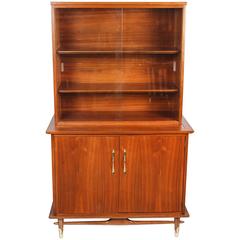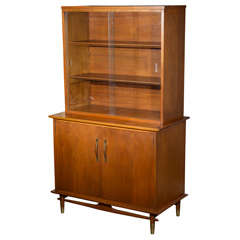Lane China Cabinet
Recent Sales
Mid-20th Century Cabinets
Vintage 1950s Cabinets
Wood, Glass
Vintage 1960s American Mid-Century Modern Dining Room Tables
Rosewood
Vintage 1970s American Brutalist Cabinets
Walnut
Vintage 1970s American Mid-Century Modern Cabinets
Glass, Wood, Burl
Vintage 1970s American Mid-Century Modern Cabinets
Brass
Vintage 1970s American Brutalist Buffets
Glass, Walnut
Vintage 1960s American Mid-Century Modern Vitrines
Rosewood
Vintage 1970s American Brutalist Cabinets
Walnut
Vintage 1960s American Mid-Century Modern Cabinets
Vintage 1960s American Mid-Century Modern Cabinets
Burl
Mid-20th Century American Mid-Century Modern Credenzas
Cane, Glass, Walnut
- What is a china cabinet called?1 Answer1stDibs ExpertOctober 12, 2021A china cabinet is a piece of furniture with a glass front, used to display porcelain or sterling silver dinnerware. It is also known as a china cabinet, breakfront or hutch. Shop a range of antique and vintage cabinets on 1stDibs.
- 1stDibs ExpertApril 5, 2022A china cabinet is a piece of furniture with glass panels used to hold and display china or ceramics. China cabinets grew in popularity in the late 1600s and 1700s with the rise of porcelain exports to Europe. You’ll find a range of china cabinets and other display cases on 1stDibs.
- 1stDibs ExpertApril 5, 2022The point of a china cabinet is to safely store valuable dinnerware, serveware and decorative objects without hiding them from sight. Because their doors feature glass panels, you can see inside but dust cannot easily enter. On 1stDibs, find a selection of antique and vintage china cabinets.
- 1stDibs ExpertApril 5, 2022Refurbishing a china cabinet comes down to restoring the wood it was made out of. Take off the hardware, sand and stain the wood and then reassemble. Voila! Just like new. Or, save the hassle and shop a variety of vintage and antique china cabinets on 1stDibs.
- 1stDibs ExpertMay 22, 2019
The main difference between a hutch and a china cabinet is their locations in a home. Although they look similar, a hutch can be placed in nearly any room and has a multipurpose use (for storage or displaying collections). A china cabinet is always in a dining room or kitchen and is used for storing and displaying fine china.
- 1stDibs ExpertAugust 17, 2021A small china cabinet is called a hutch. Shop hutches and other storage furniture on 1stDibs.
- 1stDibs ExpertApril 5, 2022For an item to be considered antique, it needs to be 100 years or older. It can be tricky to determine the age of a cabinet on your own. The best way to determine the value and age of your china cabinet is to work with a certified appraiser. You’ll find expertly vetted antique china cabinets and other furniture on 1stDibs.
- 1stDibs ExpertApril 5, 2022A low and long piece of freestanding cabinetry that can hold china and other accessories can be called a sideboard or a buffet. Both of these pieces are similar in form and function and sometimes the terms are used interchangeably. When used in the dining room it’s typically called a buffet and in the living room it’s a sideboard. Find an assortment of sideboards and buffets from some of the world’s top sellers on 1stDibs.
- 1stDibs ExpertOctober 12, 2021How much an antique china cabinet is worth depends on the style of the cabinet, age and condition. Any additional features/decorative touches might increase the worth of the cabinet. That is, a cabinet with hand painting or carving will cost more in general. Also, the older the cabinet, the more its value. An antique china cabinet can be purchased for $1500 onwards. Find a collection of antique china cabinets today on 1stDibs.
Read More
The Ultimate Guide to Types of Tables for the Home
Whether you’re just moving in or ready to give your home a makeover, our guide will give you pointers on tables that are fitting for every room, nook and hallway.
What Exactly Is a Secretary Desk, and What Is It Used For?
The furniture equivalent of a Swiss Army knife, it's the multifunctional piece you didn't know you needed.
This Shelving System with Oxidized Brass Tubes Is Retro and Futuristic at Once
Italian studio DimoreMilano mustered great ingenuity when crafting these sculptural shelves, which are built without any screws.
28 Cheerful Home Bars, Where Everybody (Literally) Knows Your Name
Simple or sophisticated, equipped with console, cart or custom cabinetry, these stylish bar areas deserve a toast.
Ask an Interior Designer: Work-from-Home Edition
Leaping into a design project, whether it's refreshing the bedroom or redoing the whole house, can be overwhelming. Luckily, we know more than a few interior designers. You asked questions on Instagram, and now they're answering.
Collected and Eclectic, ‘Wunderkammern’ Are Back in a Big Way
Introduced nearly 500 years ago, curiosity cabinets are finding new fans among today's collectors and designers.
Meet the Incredible Woman Transforming Fallen Trees into Sleek Furniture
In the hands of New York Heartwoods cofounder Megan Offner, unwanted local trees become works of design art.
These New York Architects Love a Complicated Project
From Brooklyn townhouses to Maine campgrounds, Trattie Davies and Jonathan Toews relish a challenge, like transforming a former warehouse space into the new 1stdibs Gallery.

